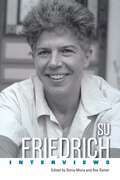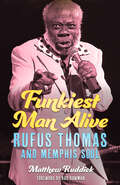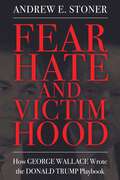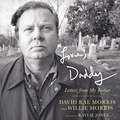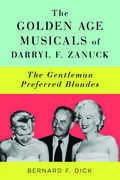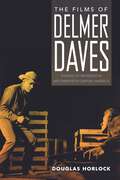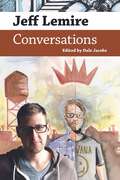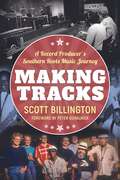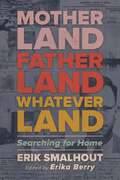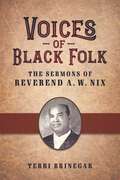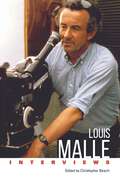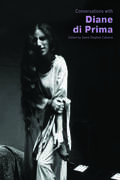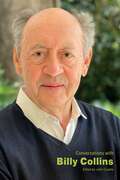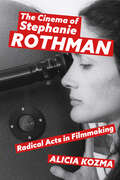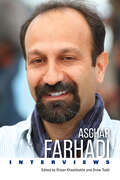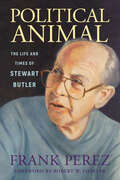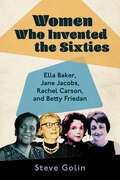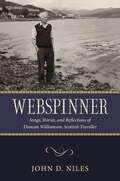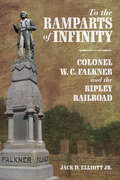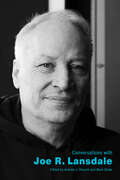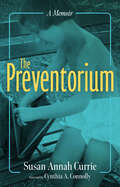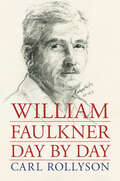- Table View
- List View
Su Friedrich: Interviews (Conversations with Filmmakers Series)
by Sonia Misra and Rox SamerSu Friedrich (b. 1954) has been described as an autobiographical filmmaker, an experimental filmmaker, a documentary filmmaker, an independent filmmaker, a feminist filmmaker, and a lesbian filmmaker—labels that she sprucely dodges, insisting time and again she is, quite simply, a filmmaker. Nevertheless, the influences of the experimental film culture and of the feminist and lesbian political ethos out of which she emerged resonate across her films to the present day. Su Friedrich: Interviews is the first volume dedicated exclusively to Friedrich and her work. The interviews collected here highlight the historical, theoretical, political, and economic dimensions through which Friedrich’s films gain their unique and defiantly ambiguous identity. The collection seeks to give a comprehensive view of Friedrich’s diverse body of work, the conditions in which her films were made, and how they have circulated and become understood within different contexts. The volume contains fifteen interviews—two previously unpublished—along with three autobiographical writings by Friedrich. Included are canonical early interviews, but a special focus is given to interviews that address her less-studied film production in the twenty-first century. Echoing across these various pieces is Friedrich’s charmingly sardonic and defiant personality, familiar from her films. Her occasional resistance to an interviewer’s line of questioning opens up other, unexpected lines of inquiry as it also provides insight into her distinct philosophy. The volume closes with a new interview conducted by the editors, which illuminates areas that remain latent or underdiscussed in other interviews, including Friedrich’s work as a film professor and projects that supplement Friedrich’s filmmaking, such as Edited By, an online historical resource dedicated to collecting information about and honoring the contributions of women film editors.
Funkiest Man Alive: Rufus Thomas and Memphis Soul (American Made Music Series)
by Matthew RuddickRufus Thomas may not be a household name, but he is widely regarded as the patriarch of Memphis R&B, and his music influenced three generations. His first singles in the early 1950s were recorded as blues transitioned into R&B, and he was arguably one of the founding fathers of early rock ’n’ roll. In the early 1960s, his songs “The Dog” and “Walking the Dog” made a huge impact on the emerging British “mod” scene, influencing the likes of the Georgie Fame, the Rolling Stones, and the Who. And in the early 1970s, Thomas rebranded himself as the “funkiest man alive” and recorded funk classics that were later sampled by the likes of Public Enemy, Missy Elliot, and the Wu-Tang Clan. In Funkiest Man Alive: Rufus Thomas and Memphis Soul, Matthew Ruddick reveals the amazing life and career of Thomas, who started as a dancer in the minstrel shows that toured the South before becoming one of the nation’s early African American disc jockeys, and then going on to record the first hit singles for both Chess Records and Stax Records. Ruddick also examines the social fabric of the city of Memphis, analyzing the factors behind the vast array of talent that appeared in the late 1950s, with singers like Isaac Hayes, William Bell, Maurice White (Earth, Wind & Fire), and Thomas’s older daughter, Carla Thomas, all emerging from the tightly knit African American community. He also tells the story of Memphis-based Stax Records, one of the nation’s leading R&B record labels. From the earliest blues, the segregated minstrel shows, and the birth of rock ’n’ roll through to the emergence of R&B and funk, Rufus Thomas saw it all.
Fear, Hate, and Victimhood: How George Wallace Wrote the Donald Trump Playbook (Race, Rhetoric, and Media Series)
by Andrew E. StonerWhen Donald Trump announced his campaign for president in 2015, journalists, historians, and politicians alike attempted to compare his candidacy to that of Governor George Wallace. Like Trump, Wallace, who launched four presidential campaigns between 1964 and 1976, utilized rhetoric based in resentment, nationalism, and anger to sway and eventually captivate voters among America’s white majority. Though separated by almost half a century, the campaigns of both Wallace and Trump broke new grounds for political partisanship and divisiveness.In Fear, Hate, and Victimhood: How George Wallace Wrote the Donald Trump Playbook, author Andrew E. Stoner conducts a deep analysis of the two candidates, their campaigns, and their speeches and activities, as well as their coverage by the media, through the lens of demagogic rhetoric. Though past work on Wallace argues conventional politics overcame the candidate, Stoner makes the case that Wallace may in fact be a prelude to the more successful Trump campaign.Stoner considers how ideas about “in-group” and “out-group” mentalities operate in politics, how anti-establishment views permeate much of the rhetoric in question, and how expressions of victimhood often paradoxically characterize the language of a leader praised for “telling it like it is.” He also examines the role of political spectacle in each candidate’s campaigns, exploring how media struggles to respond to—let alone document—demagogic rhetoric.Ultimately, the author suggests that the Trump presidency can be understood as an actualized version of the Wallace presidency that never was. Though vast differences exist, the demagogic positioning of both men provides a framework to dissect these times—and perhaps a valuable warning about what is possible in our highly digitized information society.
Love, Daddy: Letters from My Father
by David Rae Morris Willie MorrisWinner of the 2023 Mississippi Institute of Arts and Letter Award for PhotographyLove, Daddy: Letters from My Father examines the complexities of father-and-son relationships through letters and photographs. Willie Morris wrote scores of letters to his only son, David Rae Morris, from the mid-1970s until Willie’s death in 1999. From David Rae’s perspective, his father was often emotionally disconnected and lived a peculiar lifestyle, often staying out carousing well into the night. But Willie was an eloquent and accomplished writer and began to write his son long, loving, and supportive letters when David Rae was still in high school. An aspiring photographer, David Rae was confused and befuddled by his father’s warring personalities and began photographing Willie using the camera as a buffer to protect him and his emotions. The collection begins in early 1976 and continues for more than twenty years as David Rae moved about the country, living in New York, Massachusetts, Texas, Mississippi, Tennessee, and Minnesota, before finally settling in Louisiana. “All the while my father was writing to me I somehow managed to save his letters,” David Rae writes. “I left them in storage and in boxes and in piles of clutter on desks and in basements. They were kind, offering a love that he found difficult to express openly and directly. He simply was more comfortable communicating through letters.” The letters cover topics ranging from writing, the weather, Willie’s return to Mississippi in 1980, the Ole Miss football season, and local town gossip to the fleas on the dog to just life and how it’s lived. Likewise, the photographs are portraits, documentary images of daily life, dinners, outings, and private moments. Together they narrate and illuminate the complexities of one family relationship, and how, for better or worse, that love endures the passage of time.
The Golden Age Musicals of Darryl F. Zanuck: The Gentleman Preferred Blondes
by Bernard F. DickBeginning with The Jazz Singer (1927) and 42nd Street (1933), legendary Hollywood film producer Darryl F. Zanuck (1902–1979) revolutionized the movie musical, cementing its place in American popular culture. Zanuck, who got his start writing stories and scripts in the silent film era, worked his way to becoming a top production executive at Warner Bros. in the later 1920s and early 1930s. Leaving that studio in 1933, he and industry executive Joseph Schenck formed Twentieth Century Pictures, an independent Hollywood motion picture production company. In 1935, Zanuck merged his Twentieth Century Pictures with the ailing Fox Film Corporation, resulting in the combined Twentieth Century-Fox, which instantly became a new major Hollywood film entity.The Golden Age Musicals of Darryl F. Zanuck: The Gentleman Preferred Blondes is the first book devoted to the musicals that Zanuck produced at these three studios. The volume spotlights how he placed his personal imprint on the genre and how—especially at Twentieth Century-Fox—he nurtured and showcased several blonde female stars who headlined the studio’s musicals—including Shirley Temple, Alice Faye, Betty Grable, Vivian Blaine, June Haver, Marilyn Monroe, and Sheree North. Building upon Bernard F. Dick’s previous work in That Was Entertainment: The Golden Age of the MGM Musical, this volume illustrates the richness of the American movie musical, tracing how these song-and-dance films fit within the career of Darryl F. Zanuck and within the timeline of Hollywood history.
The Green Mister Rogers: Environmentalism in Mister Rogers' Neighborhood (Children's Literature Association Series)
by Sara Lindey Jason KingFred Rogers was an international celebrity. He was a pioneer in children’s television, an advocate for families, and a multimedia artist and performer. He wrote the television scripts and music, performed puppetry, sang, hosted, and directed Mister Rogers’ Neighborhood for more than thirty years. In his almost nine hundred episodes, Rogers pursued dramatic topics: divorce, death, war, sibling rivalry, disabilities, racism. Rogers’ direct, slow, gentle, and empathic approach is supported by his superior emotional strength, his intellectual and creative courage, and his joyful spiritual confidence. The Green Mister Rogers: Environmentalism in “Mister Rogers’ Neighborhood” centers on the show’s environmentalism, primarily expressed through his themed week “Caring for the Environment,” produced in 1990 in coordination with the twentieth anniversary of Earth Day. Unfolding against a trash catastrophe in the Neighborhood of Make-Believe, Rogers advances an environmentalism for children that secures children in their family homes while extending their perspective to faraway places, from the local recycling center to Florida’s coral reef. Rogers depicts animal wisdom and uses puppets to voice anxiety and hope and shows an interconnected world where each part of creation is valued, and love is circulated in networks of care. Ultimately, Rogers cultivates a practical wisdom that provides a way for children to confront the environmental crisis through action and hope and, in doing so, develop into adults who possess greater care for the environment and a capacious imagination for solving the ecological problems we face.
The Films of Delmer Daves: Visions of Progress in Mid-Twentieth-Century America
by Douglas HorlockDelmer Daves (1904–1977) was an American screenwriter, director, and producer known for his dramas and Western adventures, most notably Broken Arrow and 3:10 to Yuma. Despite the popularity of his films, there has been little serious examination of Daves’s work. Filmmaker Bertrand Tavernier has called Daves the most forgotten of American directors, and to date no scholarly monograph has focused on his work.In The Films of Delmer Daves: Visions of Progress in Mid-Twentieth-Century America, author Douglas Horlock contends that the director’s work warrants sustained scholarly attention. Examining all of Daves’s films, as well as his screenplays, scripts that were not filmed, and personal papers, Horlock argues that Daves was a serious, distinctive, and enlightened filmmaker whose work confronts the general conservatism of Hollywood in the mid-twentieth century. Horlock considers Daves’s films through the lenses of political and social values, race and civil rights, and gender and sexuality. Ultimately, Horlock suggests that Daves’s work—through its examination of bigotry and irrational fear and depiction of institutional and personal morality and freedom—presents a consistent, innovative, and progressive vision of America.
Jeff Lemire: Conversations (Conversations with Comic Artists Series)
by Dale JacobsIn a 2019 interview with the webzine DC in the 80s, Jeff Lemire (b. 1976) discusses the comics he read as a child growing up in Essex County, Ontario—his early exposure to reprints of Silver Age DC material, how influential Crisis on Infinite Earths and DC’s Who’s Who were on him as a developing comics fan, his first reading of Watchmen and The Dark Knight Returns, and his transition to reading the first wave of Vertigo titles when he was sixteen. In other interviews, he describes discovering independent comics when he moved to Toronto, days of browsing comics at the Beguiling, and coming to understand what was possible in the medium of comics, lessons he would take to heart as he began to establish himself as a cartoonist. Many cartoonists deflect from questions about their history with comics and the influences of other artists, while others indulge the interviewer briefly before attempting to steer the questions in another direction. But Lemire, creator of Essex County Trilogy, Sweet Tooth, The Nobody, and Trillium, seems to bask in these discussions. Before he was ever a comics professional, he was a fan. What can be traced in these interviews is the story of the movement from comics fan to comics professional. In the twenty-nine interviews collected in Jeff Lemire: Conversations, readers see Lemire come to understand the process of collaboration, the balancing act involved in working for different kinds of comics publishers like DC and Marvel, the responsibilities involved in representing characters outside his own culture, and the possibilities that exist in the comics medium. We see him embrace a variety of genres, using each of them to explore the issues and themes most important to him. And we see a cartoonist and writer growing in confidence, a working professional coming into his own.
Making Tracks: A Record Producer’s Southern Roots Music Journey (American Made Music Series)
by Scott BillingtonFrom the 1980s through the early 2000s, a golden era for southern roots music, producer and three-time Grammy winner Scott Billington recorded many of the period’s most iconic artists. Working primarily in Louisiana for Boston-based Rounder Records, Billington produced such giants as Irma Thomas, Charlie Rich, Buckwheat Zydeco, Johnny Adams, Bobby Rush, Ruth Brown, Beau Jocque, and Solomon Burke. The loving and sometimes irreverent profiles in Making Tracks reveal the triumphs and frustrations of the recording process, and that obsessive quest to capture a transcendent performance. Billington's long working relationships with the artists give him perspective to present them in their complexity—foibles, failures, and fabled feats—while providing a vivid look at the environs in which their music thrived. He tells about Boozoo Chavis’s early days as a musician, jockey, and bartender at his mother’s quarter horse track, and Ruth Brown’s reign as the most popular star in rhythm and blues, when the challenge of traveling on the “chitlin’ circuit” proved the antithesis of the glamour she exuded on stage. In addition, Making Tracks provides a widely accessible study in the craft of recording. Details about the technology and psychology behind the sessions abound. Billington demonstrates varying ways of achieving the mutual goal of a great record. He also introduces the supporting cast of songwriters, musicians, and engineers crucial to the magic in each recording session. Making Tracks sings unforgettably like a "from the vault" discovery.
Motherland, Fatherland, Whateverland: Searching for Home
by Erik SmalhoutErik Smalhout was born a child of privilege in the Netherlands East Indies. Smalhout’s father sent his unruly son to a boarding school in Australia, just months before the Japanese seized the Netherlands East Indies in early 1942. While young Smalhout adapted to life in rural Australia, his sister and father back home were placed in Japanese prison camps, an experience that proved fateful for his father and changed his sister’s life forever. Serendipity followed him through induction in the WWII Dutch military, his postwar service on merchant ships circling the globe, and eventually to the most southern place on earth: the Mississippi Delta. Smalhout spent the rest of his life adapting to challenging circumstances time after time: first as a progressive Dutchman in the American South, then as an IRS agent in the nation’s second-largest financial center, and finally as a man who, due to a diagnosis of Alzheimer’s, often could not identify himself. Motherland, Fatherland, Whateverland: Searching for Home is Smalhout’s memoir, edited by his granddaughter, Erika Berry, and supported with pictures and documents that he saved throughout his lifetime. Smalhout’s story reminds readers that place is secondary to experience and that no matter where we are or what fortunate or unfortunate circumstances placed us there, an eternal curiosity for humanity will help us find a place in the world.
Voices of Black Folk: The Sermons of Reverend A. W. Nix (American Made Music Series)
by Terri BrinegarRecipient of a 2023 Certificate of Merit for Best Historical Research in Recorded Blues, R&B, Gospel, Hip Hop, or Soul Music from the Association for Recorded Sound CollectionsIn the late 1920s, Reverend A. W. Nix (1880–1949), an African American Baptist minister born in Texas, made fifty-four commercial recordings of his sermons on phonographs in Chicago. On these recordings, Nix presented vocal traditions and styles long associated with the southern, rural Black church as he preached about self-help, racial uplift, thrift, and Christian values. As southerners like Nix fled into cities in the North to escape the rampant racism in the South, they contested whether or not African American vocal styles of singing and preaching that had emerged during the slavery era were appropriate for uplifting the race. Specific vocal characteristics, like those on Nix’s recordings, were linked to the image of the “Old Negro” by many African American leaders who favored adopting Europeanized vocal characteristics and musical repertoires into African American churches in order to uplift the modern “New Negro” citizen. Through interviews with family members, musical analyses of the sounds on Nix’s recordings, and examination of historical documents and relevant scholarship, Terri Brinegar argues that the development of the phonograph in the 1920s afforded preachers like Nix the opportunity to present traditional Black vocal styles of the southern Black church as modern Black voices. These vocal styles also influenced musical styles. The “moaning voice” used by Nix and other ministers was a direct connection to the “blues moan” employed by many blues singers including Blind Willie, Blind Lemon, and Ma Rainey. Both Reverend A. W. Nix and his brother, W. M. Nix, were an influence on the “Father of Gospel Music,” Thomas A. Dorsey. The success of Nix’s recorded sermons demonstrates the enduring values African Americans placed on traditional vocal practices.
Louis Malle: Interviews (Conversations with Filmmakers Series)
by Christopher BeachA filmmaker whose work exhibits a wide range of styles and approaches, Louis Malle (1932–1995) was the only French director of his generation to enjoy a significant career in both France and the United States. Although Malle began his career alongside members of the French New Wave like François Truffaut, Jean-Luc Godard, and Claude Chabrol, he never associated himself with that group. Malle is perhaps best known for his willingness to take on such difficult or controversial topics as suicide, incest, child prostitution, and collaboration with the Nazis during World War II. His filmography includes narrative films like Zazie dans le Métro, Murmur of the Heart, Atlantic City, My Dinner with Andre, and Au revoir les enfants, as well as several major documentaries. In the late 1970s, Malle moved to the United States, where he worked primarily outside of the Hollywood studio system. The films of his American period display his keen outsider’s eye, which allowed him to observe diverse aspects of American life in settings that ranged from turn-of-the-century New Orleans to present-day Atlantic City and the Texas Gulf Coast. Louis Malle: Interviews covers the entirety of Malle’s career and features seventeen interviews, the majority of which are translated into English here for the first time. As the collection demonstrates, Malle was an extremely intelligent and articulate filmmaker who thought deeply about his own choices as a director, the ideological implications of those choices, and the often-controversial themes treated in his films. The interviews address such topics as Malle’s approach to casting and directing actors, his attitude toward provocative subject matter and censorship, his understanding of the relationship between documentary and fiction film, and the differences between the film industries in France and the US. Malle also discusses his sometimes-challenging work with such actors as Brigitte Bardot, Pierre Blaise, and Brooke Shields, and sheds new light on the making of his films.
Conversations with Diane di Prima (Literary Conversations Series)
by David Stephen CalonneDiane di Prima (1934–2020) was one of the most important American poets of the twentieth century, and her career is distinguished by strong contributions to both literature and social justice. Di Prima and LeRoi Jones (Amiri Baraka) edited The Floating Bear (1962–69), one of the most significant underground publications of the sixties. Di Prima’s poetry and prose chronicle her opposition to the Vietnam War; her advocacy of the rights of Blacks, Native Americans, and the LGBTQ community; her concern about environmental issues; and her commitment to creating a world free of exploitation and poverty. In addition, di Prima is significant due to her challenges to the roles that American women were expected to play in society. Her Memoirs of a Beatnik was a sensation, and she talks about its lasting impact as well. Conversations with Diane di Prima presents twenty interviews ranging from 1972 to 2010 that chart di Prima’s intellectual, spiritual, and political evolution. From her adolescence, di Prima was fascinated by occult, esoteric, and magical philosophies. In these interviews readers can see the ways these concepts influenced both her personal life and her poetry and prose. We are able to view di Prima’s life course from her year at Swarthmore College; her move back to New York and then to San Francisco; her studies of Zen Buddhism; her fascination with the I Ching, Paracelsus, John Dee, Heinrich Cornelius Agrippa, alchemy, Tarot, and Kabbalah; and her later engagement with Tibetan Buddhism and work with Chögyam Trungpa. Another particularly interesting aspect of the book is the inclusion of interviews that explore di Prima’s career as an independent publisher—she founded Poets Press in New York and Eidolon Editions in California—and her commitment to promoting writers such as Audre Lorde. Taken together, these interviews reveal di Prima as both a writer of genius and an intensely honest, direct, passionate, and committed advocate of a revolution in consciousness.
Confessions of a Southern Beauty Queen
by Julie Hines MabusIn the late 1960s, Patsy Channing, a stunningly beautiful young woman, was suspended from the venerable Mississippi State College for Women for breach of conduct. The resulting scandal reached all the way to the Columbus courthouse, and the press ate it up. But Patsy’s story starts long before that, living with a preoccupied and troubled mother in Memphis, Tennessee. As Patsy grows up, she buries the memories of her unspeakable childhood trauma and is determined to have a normal life. Music becomes her ticket out and a vehicle for the one thing she covets most—a chance to be crowned Miss America. In Confessions of a Southern Beauty Queen, Julie Hines Mabus provides a peek into that world—a world struggling through the civil rights movement, reeling from the death of JFK, and cutting loose with the musical innovations from Memphis and Detroit. Patsy develops a close friendship with a guitarist at Stax Recording Studio, giving her firsthand exposure to the early Memphis Soul Sound created by such greats as Otis Redding, Isaac Hayes, and Sam & Dave. Confessions of a Southern Beauty Queen opens and closes with the end of Patsy’s time at Mississippi State College for Women on that fateful spring morning in 1968 when she entered the Columbus courthouse. Patsy’s story, marked with tragedy and triumph, mirrors that of a growing and evolving South, where change never comes easy.
Conversations with George Saunders (Literary Conversations Series)
by Michael O’ConnellBesides being one of America’s most celebrated living authors, George Saunders (b. 1958) is also an excellent interview subject. In the fourteen interviews included in Conversations with George Saunders, covering nearly twenty years of his career, the Booker Prize–winning author of Lincoln in the Bardo and Tenth of December provides detailed insight into his own writing process and craft, alongside nuanced interpretations of his own work. He also delves into aspects of his biography, including anecdotes from his childhood and his experiences as both a student and teacher in MFA programs, as well as reflections on how parenthood affected his writing, the role of religious belief and practice in his work, and how he has dealt with his growing popularity and fame. Throughout this collection, we see him in conversation with former students, fellow writers, mainstream critics, and literary scholars. In each instance, Saunders is eager to engage in meaningful dialogue about what he calls the “big questions of our age.” In a number of interviews, he reflects on the moral and ethical responsibility of fiction, as well as how his work engages with issues of social and political commentary. But at the same time, these interviews, like all of Saunders’s best work, are funny, warm, surprising, and wise. Saunders says he has “always enjoyed doing interviews” in part because he views “intense, respectful conversation [as], really, an artform—an exploration of sorts.” Readers of this volume will have the pleasure of joining him in this process of exploration.
Conversations with Billy Collins (Literary Conversations Series)
by John CusatisBilly Collins “puts the ‘fun’ back in profundity,” says poet Alice Fulton. Known for what he has called “hospitable” poems, which deftly blend wit and erudition, Collins (b. 1941) is a poet of nearly unprecedented popularity. His work is also critically esteemed and well represented in The Norton Anthology of American Literature. An English professor for five decades, Collins was fifty-seven when his poetry began gathering considerable international attention. Conversations with Billy Collins chronicles the poet’s career beginning with his 1998 interview with Terry Gross on Fresh Air, which exponentially expanded his readership, three years prior to his being named United States Poet Laureate. Other interviewers range from George Plimpton, founder of the Paris Review, to Pulitzer Prize–winning poet Henry Taylor to a Presbyterian pastor, a physics professor, and a class of AP English Literature students. Over the course of the twenty-one interviews included in the volume, Collins discusses such topics as discovering his persona, that consistently affable voice that narrates his often wildly imaginative poems; why poetry is so loved by children but often met with anxiety by high school students; and his experience composing a poem to be recited during a joint session of Congress on the first anniversary of 9/11, a tragedy that occurred during his tenure as poet laureate. He also explores his love of jazz, his distaste for gratuitously difficult poetry and autobiographical poems, and his beguiling invention of a mock poetic form: the paradelle. Irreverent, incisive, and deeply life-affirming—like his twelve volumes of poetry—these interviews, gathered for the first time in one volume, will edify and entertain readers in the way his sold-out readings have done for the past quarter century.
The Cinema of Stephanie Rothman: Radical Acts in Filmmaking
by Alicia KozmaThe rare woman director working in second-wave exploitation, Stephanie Rothman (b. 1936) directed seven successful feature films, served as the vice president of an independent film company, and was the first woman to win the Directors Guild of America’s student filmmaking prize. Despite these career accomplishments, Rothman retired into relative obscurity. In The Cinema of Stephanie Rothman: Radical Acts in Filmmaking, author Alicia Kozma uses Rothman’s career as an in-depth case study, intertwining historical, archival, industrial, and filmic analysis to grapple with the past, present, and future of women’s filmmaking labor in Hollywood. Understanding second-wave exploitation filmmaking as a transitory space for the industrial development of contemporary Hollywood that also opened up opportunities for women practitioners, Kozma argues that understudied film production cycles provide untapped spaces for discovering women’s directorial work. The professional career and filmography of Rothman exemplify this claim. Rothman also serves as an apt example for connecting the structure of film histories to the persistent strictures of rhetorical language used to mark women filmmakers and their labor. Kozma traces these imbrications across historical archives. Adopting a diverse methodological approach, The Cinema of Stephanie Rothman shines a needed spotlight on the problems and successes of the memorialization of women’s directorial labor, connecting historical and contemporary patterns of gendered labor disparity in the film industry. This book is simultaneously the first in-depth scholarly consideration of Rothman, the debut of the most substantive archival materials collected on Rothman, and a feminist political intervention into the construction of film histories.
Asghar Farhadi: Interviews (Conversations with Filmmakers Series)
by Ehsan Khoshbakht and Drew ToddThe winner of two Academy Awards for Best Foreign Film in only five years, Asghar Farhadi (b. 1972) has become Iran’s most prominent director since the late Abbas Kiarostami. Around the world, especially in the international festival circuit, Farhadi is considered one of the great dramatist filmmakers of his generation. His reputation and influence in his home country is even greater, though also prone to misunderstandings, controversies, and divided critical reception.This volume offers a unique perspective into Farhadi's career in several key respects. Beginning with his work in television, the interviews collected here chart his rise from theater student to Iranian dramatist to celebrated international filmmaker. The majority of the interviews were conducted in Persian and have been translated into English for the first time.In the course of his career, Farhadi has become the new hope for Iran. On both nights of his Oscar wins, Iranians flooded the streets with joy in a rare (and illegal) celebration. Yet, like other contemporary Iranian filmmakers who have struggled to reconcile their national identity with their global repute as international filmmakers, Farhadi is at once feted and under fire by his own government. In addition to making recent films outside Iran, he has taken advantage of his celebrity status to make controversial statements on topics ranging from Donald Trump to poverty and capital punishment in Iran. He even asked Iran’s Judiciary to pardon Jafar Panahi, prompting the government to temporarily withdraw permission to shoot his renowned 2011 film A Separation. Asghar Farhadi: Interviews addresses the important dimensions that characterize contemporary Iranian filmmaking. Together, these interviews shed light on what Farhadi sees as his role and responsibilities as an Iranian filmmaker in a global age.
Political Animal: The Life and Times of Stewart Butler (Willie Morris Books in Memoir and Biography)
by Frank PerezDuring Mardi Gras 1973, Stewart Butler (1930–2020) fell in love with Alfred Doolittle—a wealthy socialite and schizophrenic from San Francisco. Their relationship was an improbable love story that changed the course of LGBTQ+ history. With Doolittle’s money, Butler was able to retire and devote his life to political activism in the cause of queer liberation. A survivor of the horrific Up Stairs Lounge arson, Butler was a founding member of the first statewide lesbian and gay rights organization in Louisiana and an early champion for transgender rights, playing a key role in the eight-year struggle to persuade PFLAG to become the first national LGBTQ+ organization to include trans people in its mission statement. In Political Animal: The Life and Times of Stewart Butler, author Frank Perez traces Butler’s amazing life from his early childhood in Depression-era New Orleans, his adolescence at Carville where his father worked, his first unsuccessful attempt at college, his time in the army as a closeted gay man, his adventures in Alaska, his transformation into a hippie in the 1960s, his love affair with Doolittle, his decades as a gay rights advocate, and ultimately, his twilight years as an elder statesman. Based on Butler's own personal papers, including hundreds of letters, and dozens of interviews, Political Animal paints an intimate portrait of a legendary figure in gay politics and the times in which he lived.
Women Who Invented the Sixties: Ella Baker, Jane Jacobs, Rachel Carson, and Betty Friedan
by Steve GolinWhile there were many protests in the 1950s—against racial segregation, economic inequality, urban renewal, McCarthyism, and the nuclear buildup—the movements that took off in the early 1960s were qualitatively different. They were sustained, not momentary; they were national, not just local; they changed public opinion, rather than being ignored. Women Who Invented the Sixties tells the story of how four women helped define the 1960s and made a lasting impression for decades to follow. In 1960, Ella Baker played the key role in the founding of the Student Nonviolent Coordinating Committee, which became an essential organization for students during the civil rights movement and the model for the antiwar and women’s movements. In 1961, Jane Jacobs published The Death and Life of Great American Cities, changing the shape of urban planning irrevocably. In 1962, Rachel Carson published Silent Spring, creating the modern environmental movement. And in 1963, Betty Friedan wrote The Feminine Mystique, which sparked second-wave feminism and created lasting changes for women. Their four separate interventions helped, together, to end the 1950s and invent the 1960s.Women Who Invented the Sixties situates each of these four women in the 1950s—Baker’s early activism with the NAACP and the Southern Christian Leadership Conference, Jacobs’s work with Architectural Forum and her growing involvement in neighborhood protest, Carson’s conservation efforts and publications, and Friedan’s work as a labor journalist and the discrimination she faced—before exploring their contributions to the 1960s and the movements they each helped shape.
Webspinner: Songs, Stories, and Reflections of Duncan Williamson, Scottish Traveller
by John D. NilesBorn in 1928 in a tent on the shore of Loch Fyne, Argyll, Duncan Williamson (d. 2007) eventually came to be recognized as one of the foremost storytellers in Scotland and the world. Webspinner: Songs, Stories, and Reflections of Duncan Williamson, Scottish Traveller is based on more than a hundred hours of tape-recorded interviews undertaken with him in the 1980s. Williamson tells of his birth and upbringing in the west of Scotland, his family background as one of Scotland’s seminomadic travelling people, his varied work experiences after setting out from home at about age fifteen, and the challenges he later faced while raising a family of his own, living on the road for half the year. The recordings on which the book is based were made by John D. Niles, who was then an associate professor at the University of California, Berkeley. Niles has transcribed selections from his field tapes with scrupulous accuracy, arranging them alongside commentary, photos, and other scholarly aids, making this priceless self-portrait of a brilliant storyteller available to the public. The result is a delight to read. It is also a mine of information concerning a vanished way of life and the place of singing and storytelling in Traveller culture. In chapters that feature many colorful anecdotes and that mirror the spontaneity of oral delivery, readers learn much about how Williamson and other members of his persecuted minority had the resourcefulness to make a living on the outskirts of society, owning very little in the way of material goods but sustained by a rich oral heritage.
To the Ramparts of Infinity: Colonel W. C. Falkner and the Ripley Railroad
by Jack D. Elliott Jr.Before William Faulkner, there was Colonel William C. Falkner (1825–1889), the great-grandfather of the prominent and well-known Mississippi writer. The first biography of Falkner was a dissertation by the late Donald Duclos, which was completed in 1961, and while Faulkner scholars have briefly touched on the life of the Colonel due to his influence on the writer’s work and life, there have been no new biographies dedicated to Falkner until now. To the Ramparts of Infinity: Colonel W. C. Falkner and the Ripley Railroad seeks to fill this gap in scholarship and Mississippi history by providing a biography of the Colonel, sketching out the cultural landscape of Ripley, Mississippi, and alluding to Falkner’s influence on his great-grandson’s Yoknapatawpha cycle of stories. While the primary thrust of the narrative is to provide a sound biography on Falkner, author Jack D. Elliott Jr. also seeks to identify sites in Ripley that were associated with the Colonel and his family. This is accomplished in part within the main narrative, but the sites are specifically focused on, summarized, and organized into an appendix entitled “A Field Guide to Colonel Falkner’s Ripley.” There, the sites are listed along with old and contemporary photographs of buildings. Maps of the area, plotting military action as well as the railroads, are also included, providing essential material for readers to understand the geographical background of the area in this period of Mississippi history.
Conversations with Joe R. Lansdale (Literary Conversations Series)
by Andrew J. Rausch and Mark SladeJoe R. Lansdale (b. 1951), the award-winning author of such novels as Cold in July (1989) and The Bottoms (2000), as well as the popular Hap and Leonard series, has been publishing novels since 1981. Lansdale has developed a tremendous cult audience willing to follow him into any genre he chooses to write in, including horror, western, crime, adventure, and fantasy. Within these genres, his stories, novels, and novellas explore friendship, race, and life in East Texas. His distinctive voice is often funny and always unique, as characterized by such works as Bubba Ho-Tep (1994), a novella that centers on Elvis Presley, his friend who believes himself to be John F. Kennedy, and a soul-sucking ancient mummy. This same novella won a Bram Stoker Award, one of the ten Bram Stoker Awards given to Lansdale thus far in his illustrious career. Wielding a talent that extends beyond the page to the screen, Landsdale has also written episodes for Batman: The Animated Series and Superman: The Animated Series. Conversations with Joe R. Lansdale brings together interviews from newspapers, magazines, and podcasts conducted throughout the prolific author’s career. The collection includes conversations between Lansdale and other noted peers like Robert McCammon and James Grady; two podcast transcripts that have never before appeared in print; and a brand-new interview, exclusive to the volume. In addition to shedding light on his body of literary work and process as a writer, this collection also shares Lansdale’s thoughts on comics, atheism, and martial arts.
The Preventorium: A Memoir (Cultures of Childhood)
by Susan Annah CurrieNamed the 2023 Best Memoir on Health/Adverse Childhood Experiences by Memoir MagazineOpened on February 17, 1929, the Mississippi State Preventorium operated continuously until 1976. The Mississippi Preventorium, like similar hospitals throughout the country, was an institution for sickly, anemic, and underweight children. It was established on the grounds of the Mississippi State Tuberculosis Sanitorium in the early years of the twentieth century when tuberculosis was a dreaded disease worldwide. The TB Sanitorium hospital housed those with tuberculosis, offering refuge for patients of all ages afflicted with the pernicious and contagious disease. Although located on the same medical campus, the preventorium was a separate medical institution for children; no children with TB were admitted in the sixty-year run of the hospital. The name preventorium meant a place of preventing disease as there was a fear of sickly children contracting TB. The Mississippi Preventorium was one of the last, if not the very last, of these special hospitals for children. Now closed, the preventorium housed over three thousand children, including author Susan Annah Currie. In this intimate memoir, Currie details her fifteen-month stay at the preventorium. From her arrival in May 1959 at six years old, Currie vividly explores the unique and isolating world that she and children across the country experienced. Her exacting routine, dictated by the nurses and doctors who now acted as her parents, erased the distinction between patients and created both a sense of community among the children and a deep sense of loneliness. From walking silently single file through the cold, narrow halls of the hospital to nurses recording every detail of their bathroom habits to extremely limited visitation from family, Currie’s time at the preventorium changed her and those around her, leaving an indelible mark even after their return home. While many of the records from the preventorium have been lost, Currie’s memoir opens to readers a lost history largely forgotten. Told in evocative prose, The Preventorium explores Currie’s personal trials, both in the hospital and in the echoes of her experiences into adulthood.
William Faulkner Day by Day
by Carl RollysonWilliam Faulkner has been the topic of numerous biographies, papers, and international attention. Yet there are no collected resources providing a comprehensive scope of Faulkner’s life and work before now. William Faulkner Day by Day provides unique insight into the daily life of one of America’s favorite writers. Beyond biography, this book is an effort to recover the diurnal Faulkner, to write in the present tense about past events as if they are happening now. More importantly, this book is concerned with more than the writer’s life. Instead, it examines the whole man—the daily, mundane, profound, life changing, and everything in between. Spanning from the 1825 birth of Faulkner’s great-grandfather to Faulkner’s death 137 years later to the day, author and biographer Carl Rollyson presents for the first time a complete portrait of Faulkner’s life untethered from any one biographical or critical narrative. Presented as a chronology of events without comment, this book is accompanied by an extensive list of principal personages and is supported by extensive archival research and interviews. Populated by the characters of Faulkner’s life—including family and friends both little known and internationally famous—this book is for Faulkner readers of all kinds with a wide variety of interests in the man and his work.
